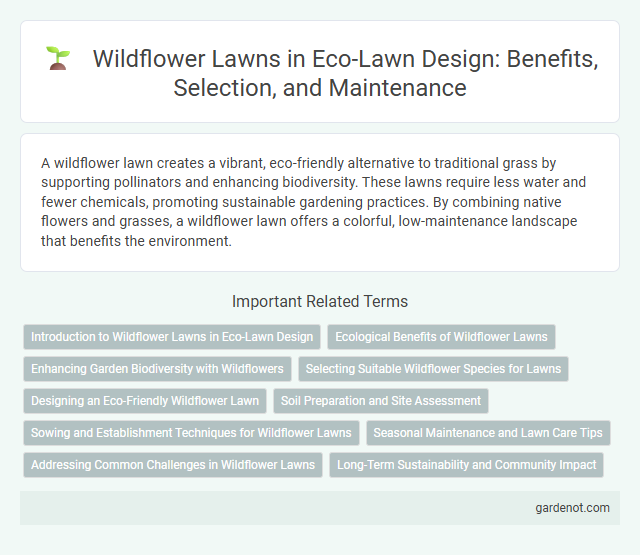A wildflower lawn creates a vibrant, eco-friendly alternative to traditional grass by supporting pollinators and enhancing biodiversity. These lawns require less water and fewer chemicals, promoting sustainable gardening practices. By combining native flowers and grasses, a wildflower lawn offers a colorful, low-maintenance landscape that benefits the environment.
Introduction to Wildflower Lawns in Eco-Lawn Design
Wildflower lawns enhance eco-lawn design by promoting biodiversity and supporting pollinators such as bees and butterflies. These low-maintenance lawns reduce the need for chemical fertilizers and water, contributing to sustainable gardening practices. Integrating native wildflower species ensures resilience and harmony with local ecosystems in eco-friendly landscaping.
Ecological Benefits of Wildflower Lawns
Wildflower lawns support biodiversity by providing essential habitats and nectar sources for pollinators such as bees and butterflies, crucial for ecosystem health. These lawns improve soil quality and reduce erosion through deep root systems, enhancing groundwater retention and soil stability. Wildflower lawns require less water and chemical inputs compared to traditional grass lawns, promoting sustainable landscaping and reducing environmental pollution.
Enhancing Garden Biodiversity with Wildflowers
Wildflower lawns significantly enhance garden biodiversity by attracting a wide variety of pollinators such as bees, butterflies, and other beneficial insects essential for ecosystem health. These lawns support native flora and fauna, creating habitats that promote natural pest control and soil fertility. Incorporating diverse wildflower species ensures seasonal blooms, contributing to a resilient and vibrant garden environment.
Selecting Suitable Wildflower Species for Lawns
Choosing suitable wildflower species for an eco-lawn involves selecting native plants adapted to local soil, climate, and sunlight conditions, ensuring sustainability and minimal maintenance. Perennials such as clover, oxeye daisy, and bird's-foot trefoil promote biodiversity while providing seasonal color and supporting pollinators like bees and butterflies. Including drought-tolerant, low-growing wildflowers helps maintain lawn resilience and reduces the need for frequent watering and mowing.
Designing an Eco-Friendly Wildflower Lawn
Designing an eco-friendly wildflower lawn involves selecting native wildflower species adapted to local soil and climate conditions, which supports biodiversity and pollinators. Incorporate a diverse mix of perennials and annuals with staggered blooming periods to ensure continuous habitat and food sources throughout the growing season. Use organic soil amendments and avoid synthetic fertilizers or pesticides to maintain soil health and reduce environmental impact.
Soil Preparation and Site Assessment
Effective wildflower lawn establishment begins with thorough soil preparation, including soil testing to determine pH levels and nutrient content critical for native species growth. Site assessment involves evaluating sunlight exposure, drainage patterns, and existing vegetation to ensure optimal conditions for wildflower germination and sustainability. Amending soil with organic matter and removing invasive species enhances seedbed quality, promoting healthy root development and biodiversity in the eco-lawn.
Sowing and Establishment Techniques for Wildflower Lawns
Sowing wildflower lawns requires selecting native or regionally adapted seed mixes that match local soil and climate conditions for optimal establishment. Prepare the soil by removing existing vegetation and lightly raking to create a fine seedbed, ensuring good seed-to-soil contact to enhance germination rates. Sow seeds at the recommended depth and density during early spring or autumn, followed by consistent moisture management to support seedling growth and successful lawn establishment.
Seasonal Maintenance and Lawn Care Tips
Wildflower lawns require minimal seasonal maintenance compared to traditional grass, thriving with periodic mowing to encourage blooms and prevent overgrowth. Spring and early summer involve light fertilization and selective weeding to promote a diverse plant ecosystem while enhancing soil health. Regular watering during dry spells supports vibrant growth and ensures pollinator-friendly habitats throughout the growing season.
Addressing Common Challenges in Wildflower Lawns
Wildflower lawns often face challenges such as uneven growth, weed invasion, and inconsistent bloom periods. Selecting native wildflower species and implementing proper soil preparation enhances resilience and ensures vibrant, long-lasting blooms. Regular maintenance practices like targeted mowing and overseeding help control weeds and promote healthy plant diversity.
Long-Term Sustainability and Community Impact
Wildflower lawns promote long-term sustainability by enhancing biodiversity and reducing the need for chemical fertilizers and pesticides, fostering a healthier ecosystem. They support pollinators such as bees and butterflies, which are crucial for maintaining local flora and agricultural productivity. Community engagement in creating and maintaining wildflower lawns strengthens environmental stewardship and awareness at the neighborhood level.
Wildflower lawn Infographic

 gardenot.com
gardenot.com